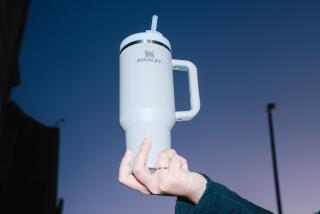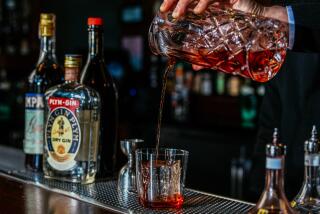Tiny bottles make them happy.
- Share via
Perhaps on the third Monday of every odd-numbered month, collectors of similar passion gather to ogle airline cocktail napkins. But on the second Sunday of this even-numbered month of August, two dozen or so boisterous members of the Lilliputian Bottle Club have converged upon a Hawthorne conference room to lavish enormous attention on vessels of glass and porcelain. A few of the friendly middle-aged and elderly faces hark back to 1970, the club’s inaugural year. Many are instantly recognizable to subscribers of the newsletter “Gulliver’s Gazette” and will doubtless be seen milling around at the club’s 16th Annual Collector’s Show in Anaheim in October.
There’s Kurt Sebert, who traces his Lilliputian fascination to the Navy, when a friend slipped him a couple of tiny Seagram’s V.O. bottles before he shipped out. There’s hale Hamilton Stanford, who began collecting “in the Civil War, I think” and whose collection now encompasses 2,500 miniatures of gin. Then there’s Gary Anderson, a 57-year-old printer from Newport Beach who’s rescued miniatures in the shapes of the Hacienda, the Dunes, the Landmark and other bulldozed Las Vegas casinos that were handed out to yesterday’s high rollers.
David Spaid, the club’s past president and perennial historian, has verified a miniature liquor bottle dating from the early 1860s--well before the airlines made them ubiquitous. By the turn of the century, he says, whiskey salesmen were hauling them around as samples as they hawked their line to tavern keepers. Miniatures from Al Capone’s distillery are scarce, and some bans on Lilliputian bottles outlasted Prohibition. In 1938, the California State Assembly put into effect a law that prevented the sale of wee liquor bottles. “It was pushed through because of a lot of lobbying from people who owned restaurants and bars,” Spaid says. The law, which would not be repealed for 40 years, was targeted at drinkers tempted to bypass the local bar for a cheaper miniature Scotch bought at the corner store.
Where the airlines spurred the mass proliferation of Lilliputian bottles, they now actively contribute to their aesthetic decline by forsaking glass for plastic. “It was strictly because of how much fuel they could save,” Spaid says. No grand historical or legislative grasp is necessary to predict the Lilliputians’ reaction to this most unwelcome eventuality.
“They’d rather have glass,” Spaid says. “Plastic’s cheap.”
More to Read
Eat your way across L.A.
Get our weekly Tasting Notes newsletter for reviews, news and more.
You may occasionally receive promotional content from the Los Angeles Times.










